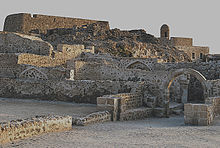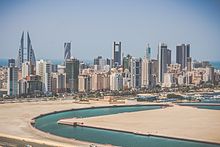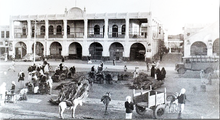Manama
Manama
الْمَنَامَة | |
|---|---|
Capital | |
| Government | |
| • Governor | Hamad bin Isa Al Khalifa |
| Area | |
| • Capital city | 30 km2 (10 sq mi) |
| Population | |
| • Estimate (2020) | 200,000 |
| • Density | 5,200/km2 (13,000/sq mi) |
| • Urban (2020)[1] | 635,000 |
| • Capital Governorate (2020) | 534,939 |
| Time zone | GMT+3 |
| Block number | 3XX–4XX |
| Website | capital |
Manama (
Although the current twin cities of Manama and Muharraq appear to have been founded simultaneously in the 1800s,[2] Muharraq took prominence due to its defensive location and was thus the capital of Bahrain until 1923. Manama became the mercantile capital and was the gateway to the main Bahrain Island.[3] In the 20th century, Bahrain's oil wealth helped spur fast growth and in the 1990s a concerted diversification effort led to expansion in other industries and helped transform Manama into an important financial hub in the Middle East. Manama was designated as the 2012 capital of Arab culture by the Arab League, and a beta global city by the Globalization and World Cities Research Network in 2018.[4][5]
Etymology
The name is derived from the Arabic word الْمَنَامَة (el-Menâme) meaning "the place of rest" or "the place of dreams".[6]
History
Pre-modern history
There is evidence of human settlement on the northern coastline of Bahrain dating back to the
"The capital of Awal... is a town well populated whose environs are fertile and produce corn and dates in abundance."
—
Al-Idrisi[10]

The commercial network of Dilmun lasted for almost 2,000 years, after which the

In 1330, under the
Early modern history
The Safavids, sidelining Manama, designated the nearby town of
Persian control over the Persian Gulf waned during the later half of the 18th century. At this time, Bahrain archipelago was a dependency of the emirate of

The
Modern history

Following the outbreak of
In 1927, the country's pearling economy collapsed due to the introduction of Japanese cultured pearls in the world market. It is estimated that between 1929 and 1931, pearling entrepreneurs lost more than two-thirds of their income. Further aggravated by the

Following the rise of


Post-independence Manama was characterised by the rapid urbanisation of the city and the swallowing-up of neighboring villages and hamlets into a single urbanised area, incorporating new neighbourhoods such as
Government

Historically, Manama has been restricted to what is now known as the Manama Souq and the Manama Fort (now the Ministry of Interior) to its south. However the city has now grown to include a number of newer suburban developments as well as older neighboring villages that have been engulfed by the growth of the city. The districts that make up Manama today include:
Manama is part of the
Economy

Manama is the focal point of the Bahraini economy. While petroleum has decreased in importance in recent years due to depleting reserves and growth in other industries, it is still the mainstay of the economy.
Manama's economy in the early 20th century relied heavily on
Historically, the ports at Manama were of poor reputation. The British described the ports importing systems as being "very bad – goods were exposed to the weather and there were long delays in delivery", in 1911. Indians began maintaining the ports and new resources were built on site, improving the situation. As of 1920, Manama was one of the main exporters of Bahrain pearls, attracting steamships from India. During this time, they also imported goods from India and from other regional countries. They imported rice, textiles, ghee, coffee, dates, tea, tobacco, fuel, and livestock. They exported less of a variety, with a focus on pearls, oysters, and sailcloth. For the year of 1911–12, Manama was visited by 52 steamships, the majority being British and the rest Turkish-Arabian.[40]
Demographics
| Year | Pop. | ±% |
|---|---|---|
| 1860s | 8,000 | — |
| 1904 | 25,000 | +212.5% |
| 1941 | 27,835 | +11.3% |
| 1950 | 39,648 | +42.4% |
| 1959 | 61,726 | +55.7% |
| 1965 | 79,098 | +28.1% |
| 1971 | 88,785 | +12.2% |
| 1981 | 121,986 | +37.4% |
| 2010 | 329,510 | +170.1% |
| Source:[41] Bahrain Census 2010 | ||
The role of Manama as a regional port city in the Persian Gulf made it a hub for migrant workers in search of a better living. As a result, Manama has often been described, both in the pre-oil and post-oil era, as a cosmopolitan city.[42] In 1904, it was estimated that Manama's population numbered 25,000, out of which half were believed to have been foreigners from Basra, Najd, al-Hasa and Iran, as well as from India and Europe.[20]
Religion
The two main branches of
Transport
Road network




Manama is the main hub of the country's road network. At the moment the city's road network is undergoing substantial development to ameliorate the situation of traffic in the city. Due to the fact that it is the capital and the main city in the country, where most of the government and the commercial offices and facilities are established, along with the entertainment centers, and the country's fast growth, vehicle population is increasing rapidly.
The widening of roads in the old districts of Manama and the development of a national network linking the capital to other settlements commenced as early as the arrival of the first car in 1914.
A series of
To the south of Manama, roads connected groves, lagoons and marshes of

The four main islands and all the towns and villages are linked by well-constructed roads. There were 3,164 km (1,966 mi) of roadways in 2002, of which 2,433 km (1,512 mi) were paved. A
Bahrain's port of
Buses

Manama has a bus service that launched on 1 April 2015, with a fleet of 141 MAN buses.[44] Regulated by the Ministry of Transportation, bus routes extend across Bahrain and around Manama with fares of a minimum 200 Fils (BD0.200) (around $0.50(USD); £0.30).[45]
Air transport
Bahrain International Airport is located on the nearby Muharraq Island, approximately 7 km (4 mi) from the CBD. It is a premier hub airport in the Middle East. Strategically located in the Northern Persian Gulf between the major markets of Saudi Arabia and Iran, the airport has one of the widest range and highest frequency of regional services with connections to major international destinations in Europe, Asia, Africa, and North America. Bahrain also has a military airbase, the Isa Air Base, located in the south at Sakhir. This is the base of the Bahrain Defence Force, or BDF.
Education
Quranic schools were the only source of education in Bahrain prior to the 20th century; such schools were primarily dedicated to the study of the
Following the end of the
In 1926, a second public school for boys opened up in Manama called the Jafaria School. Two years later, in 1928, the first public school for girls was established. Due to financial constraints suffered by the Education Committee, the Bahraini government took control of the schools in 1930.[46]
Presently, Manama has a wide range of private and public universities and colleges such as Ahlia University, Applied Science University, Arab Open University, Arabian Gulf University, Bahrain Institute of Banking and Finance, and the College of Health and Sport Sciences. Other notable primary and secondary schools situated in the city include the Bahrain School, the Indian School, Al Raja School amongst others.
Geography
The city is located in the north-eastern corner of
Climate
Manama has an
| Climate data for Manama (Bahrain International Airport) 1991–2020 normals, extremes 1902–present | |||||||||||||
|---|---|---|---|---|---|---|---|---|---|---|---|---|---|
| Month | Jan | Feb | Mar | Apr | May | Jun | Jul | Aug | Sep | Oct | Nov | Dec | Year |
| Record high °C (°F) | 29.7 (85.5) |
34.7 (94.5) |
38.1 (100.6) |
41.3 (106.3) |
46.7 (116.1) |
47.3 (117.1) |
47.5 (117.5) |
45.6 (114.1) |
45.5 (113.9) |
42.8 (109.0) |
37.2 (99.0) |
30.6 (87.1) |
47.5 (117.5) |
| Mean daily maximum °C (°F) | 20.7 (69.3) |
22.0 (71.6) |
25.5 (77.9) |
30.6 (87.1) |
36.1 (97.0) |
38.6 (101.5) |
39.7 (103.5) |
39.6 (103.3) |
37.7 (99.9) |
34.0 (93.2) |
28.0 (82.4) |
22.9 (73.2) |
31.3 (88.3) |
| Daily mean °C (°F) | 17.5 (63.5) |
18.4 (65.1) |
21.3 (70.3) |
26.0 (78.8) |
31.1 (88.0) |
34.0 (93.2) |
35.1 (95.2) |
35.1 (95.2) |
33.2 (91.8) |
29.9 (85.8) |
24.6 (76.3) |
19.7 (67.5) |
27.2 (80.9) |
| Mean daily minimum °C (°F) | 14.5 (58.1) |
15.4 (59.7) |
18.1 (64.6) |
22.4 (72.3) |
27.2 (81.0) |
30.0 (86.0) |
31.4 (88.5) |
31.5 (88.7) |
29.5 (85.1) |
26.4 (79.5) |
21.6 (70.9) |
16.8 (62.2) |
23.7 (74.7) |
| Record low °C (°F) | 2.7 (36.9) |
7.9 (46.2) |
10.9 (51.6) |
10.8 (51.4) |
18.7 (65.7) |
18.4 (65.1) |
25.3 (77.5) |
21.8 (71.2) |
18.9 (66.0) |
18.8 (65.8) |
11.7 (53.1) |
6.4 (43.5) |
2.7 (36.9) |
| Average precipitation mm (inches) | 18.1 (0.71) |
13.0 (0.51) |
14.7 (0.58) |
7.5 (0.30) |
8.0 (0.31) |
0.0 (0.0) |
0.0 (0.0) |
0.0 (0.0) |
0.0 (0.0) |
0.9 (0.04) |
16.8 (0.66) |
15.2 (0.60) |
94.2 (3.71) |
| Average precipitation days (≥ 1.0 mm) | 2.5 | 1.9 | 2.5 | 1.3 | 0.3 | 0.0 | 0.0 | 0.0 | 0.0 | 0.2 | 1.6 | 2.3 | 12.6 |
| Average relative humidity (%)
|
69.1 | 67.2 | 61.5 | 54.4 | 47.6 | 46.2 | 50.7 | 58.0 | 59.2 | 62.3 | 63.6 | 68.7 | 59.0 |
| Average dew point °C (°F) | 11.5 (52.7) |
11.8 (53.2) |
13.1 (55.6) |
15.4 (59.7) |
17.8 (64.0) |
19.9 (67.8) |
22.5 (72.5) |
25.0 (77.0) |
23.7 (74.7) |
21.5 (70.7) |
17.0 (62.6) |
13.7 (56.7) |
17.7 (63.9) |
| Mean monthly sunshine hours | 232 | 221 | 245 | 256 | 316 | 344 | 337 | 334 | 316 | 306 | 249 | 235 | 3,391 |
| Source: NOAA,[50] Meteo Climat (record highs and lows)[51] | |||||||||||||
Culture

The country attracts a large number of foreigners and foreign influences, with just under one-third of the population hailing from abroad.[citation needed] Alcohol is legal in the country, with bars and nightclubs operating in the city. Bahrain gave women the right to vote in elections for the first time in 2002. Football is the most popular sport in Manama (and the rest of the country), with three teams from Manama participating in the Bahraini Premier League.
Notable cultural sites within Manama include the
Notable people
- Hamad Al Fardan (born 1987), racing driver and musician
- Fahad Al Musalam (born 1974), racing driver
- Mohamed Ali Al-Shaaban (born 1986), television personality and surgeon
- Faisal Buressli (born 1961), former basketball player and current coach
- Hussain Karimi (born 1983), racing driver
Twin towns and sister cities
|
See also
Notes
- ^ These student protests were led by intellectuals and poets such as Qassim Haddad.[31]
References
Citations
- ^ Annual Population of Urban Agglomerations with 300,000 Inhabitants or More in 2014, by Country, 1950–2030 (thousands), World Urbanization Prospects, the 2014 revision Archived 18 February 2015 at the Wayback Machine, Population Division of the United Nations Department of Economic and Social Affairs. Note: List based on estimates for 2015, from 2014. Retrieved 11 February 2017.
- ^ Ben Hamouche 2008, p. 185.
- ^ Ben Hamouche 2008, p. 186.
- ^ Manama Capital of Arab Culture 2012
- ^ "Ministry of Culture: Manama as the Bahraini Capital of Arab Culture". Archived from the original on 11 September 2014. Retrieved 9 October 2014.
- ^ Room 1997, p. 223.
- ^ Al-Nabi 2012, p. 17.
- ^ a b c d e Dumper & Stanley 2007, p. 243.
- ^ Ben Hamouche 2008, p. 184.
- ^ a b Al-Nabi 2012, p. 19.
- ^ Rice 2005, p. 128.
- ^ Al A'ali, Mohammed (24 August 2013). "Protecting Bahrain's Christian heritage..." Gulf Daily News. Archived from the original on 25 August 2013. Retrieved 31 August 2013.
- ^ a b c Dumper & Stanley 2007, p. 244.
- ^ a b Larsen 1983, p. 68.
- ^ a b c Fuccaro 2009, p. 18.
- ^ Fuccaro 2005, p. 42.
- ^ a b Fuccaro 2005, p. 43.
- ^ Palgrave 1866.
- ^ Ben Hamouche 2008, p. 192.
- ^ a b Fuccaro 2005, p. 44.
- ^ a b Fuccaro 2009, p. 64.
- ^ a b Fuccaro 2009, p. 113.
- ^ Fuccaro 2009, p. 114.
- ^ Fuccaro 2009, p. 115.
- ^ Fuccaro 2009, p. 127-128.
- ^ a b Fuccaro 2009, p. 119.
- ^ Fuccaro 2009, p. 163.
- ^ Ben Hamouche 2008, p. 201.
- ^ Fuccaro 2009, p. 185-186.
- ^ Fuccaro 2009, p. 116.
- ^ a b Fuccaro 2009, p. 227.
- ^ Fuccaro 2009, p. 226.
- ^ Fuccaro 2009, p. 229.
- ^ Ben Hamouche 2008, p. 206.
- ^ a b c Fuccaro 2009, p. 230.
- ^ "Bahrain Independent Commission of Inquiry". Retrieved 14 September 2013.
- ^ Development Team at BNA. "Bahrain News Agency – ELECTION 2006 (retrieved 2 December 2006)". Archived from the original on 3 July 2010. Retrieved 28 June 2010.
- ^ CIA World Factbook – Bahrain (retrieved 2 December 2006)
- ^ Al-Nabi 2012, p. 20.
- ^ Prothero, G.W. (1920). Arabia. London: H.M. Stationery Office. p. 73.
- ^ Ben Hamouche 2008, p. 202.
- ^ a b Ben Hamouche 2008, p. 191.
- ^ ISBN 978-1134128211.
- ^ Al Omari, Ahmed (16 February 2015). "Clean, comfortable and punctual..." Gulf Daily News. Retrieved 27 May 2015.
- ^ "Ministry of Transportation – Public Buses". Archived from the original on 27 May 2015. Retrieved 27 May 2015.
- ^ a b c d "History". Ministry of Education – Bahrain. Archived from the original on 18 January 2013. Retrieved 20 January 2013.
- ^ Shirawi 1987, p. 59.
- ^ Shirawi 1987, p. 60.
- ^ Shirawi 1987, p. 61.
- ^ "Bahrain International Airport Climate Normals 1991–2020". National Oceanic and Atmospheric Administration. Retrieved 10 October 2023.
- ^ "Station Bahrain" (in French). Météo Climat. Retrieved 14 October 2016.
- ISBN 978-1-907065-58-3. Retrieved 11 March 2020.
- ^ "Manama Souq revamp will be finished by mid-2020". Time Out Bahrain. Retrieved 11 March 2020.
Bibliography
Primary sources
- Palgrave, William Gifford(1866). Narrative of a Year's Journey through Central and Eastern Arabia (1862–1863). Vol. II. London: Macmillan & Co.
Secondary sources
- Al-Nabi, Mohammed Noor (2012). The History of Land Use and Development in Bahrain (PDF). ISBN 9789995801298. Archived from the original(PDF) on 1 October 2018. Retrieved 16 September 2013.
- Ben Hamouche, Mustapha (2008). Manama: The Metamorphosis of an Arab Gulf City. Routledge. ISBN 9781134128211.
- Dumper, Michael; Stanley, Bruce E. (2007). Cities of the Middle East and North Africa: A Historical Encyclopedia. ABC-CLIO. ISBN 9781576079195.
- Fuccaro, Nelida (2005). Mapping the transnational community: Persians and the space of the city in Bahrain, c. 1869–1937. Routledge. ISBN 9780415331357.
- Fuccaro, Nelida (2009). Histories of City and State in the Persian Gulf: Manama Since 1800. Cambridge University Press. ISBN 9780521514354.
- Larsen, Curtis E. (1983). Life and Land Use on the Bahrain Islands: The Geoarchaeology of an Ancient Society. University of Chicago Press. ISBN 9780226469065.
- Rice, Michael (2005). Traces of Paradise: The Archaeology of Bahrain, 2500 BC to 300 AD. I.B. Tauris. ISBN 9781860647420.
- Room, Adrian (1997). Placenames of the world: origins and meanings of the names for over 5000 natural features, countries, capitals, territories, cities and historic sights. Jefferson, North Carolina: McFarland. ISBN 9780786418145.
- Shirawi, May Al-Arrayed (1987). Education in Bahrain—1919–1986 An Analytical Study of Problems and Progress (PDF). Durham University.
External links
- Official website (in Arabic)





